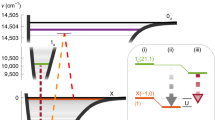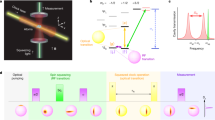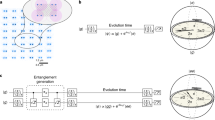Abstract
Quantum statistics fundamentally controls the way particles interact; bosons tend to bunch together, whereas fermions repulse each other. As a consequence, statistically different isotopes are found in different macroscopic quantum states at ultracold temperatures. This is related to the total atomic spin, which forces atoms to couple to ambient fields. In designing high-precision atomic clocks that operate at a fractional uncertainty of 10−15 or less, quantum statistics and therefore the spins of the interrogated atoms have an essential role in determining the clocks’ ultimate performance. Here, we discuss the design of optical lattice clocks in view of the quantum statistics and lattice geometries. We propose two configurations that both make the interrogated atoms non-interacting: spin-polarized fermions in a one-dimensional (1D) and bosons in a 3D lattice. A 3D clock with bosonic 88Sr is demonstrated for the first time, in addition to a 1D clock with fermionic 87Sr. The sequential operation of the two clocks enables us to evaluate the clock stability with an uncertainty below 1×10−15 and to determine the isotope shift with significant reduction of the uncertainty related to atomic collisions.
This is a preview of subscription content, access via your institution
Access options
Subscribe to this journal
Receive 12 print issues and online access
$209.00 per year
only $17.42 per issue
Buy this article
- Purchase on Springer Link
- Instant access to full article PDF
Prices may be subject to local taxes which are calculated during checkout





Similar content being viewed by others
References
Dehmelt, H. G. Mono-ion oscillator as potential ultimate laser frequency standard. IEEE Trans. Instrum. Meas. 31, 83–87 (1982).
Rosenband, T. et al. Frequency ratio of Al+ and Hg+ single-ion optical clocks; metrology at the 17th decimal place. Science 319, 1808–1812 (2008).
Katori, H. in The 6th Symp. on Frequency Standards and Metrology (ed. Gill, P.) 323–330 (World Scientific, 2002).
Takamoto, M., Hong, F. L., Higashi, R. & Katori, H. An optical lattice clock. Nature 435, 321–324 (2005).
Katori, H., Takamoto, M., Pal’chikov, V. G. & Ovsiannikov, V. D. Ultrastable optical clock with neutral atoms in an engineered light shift trap. Phys. Rev. Lett. 91, 173005 (2003).
Baillard, X. et al. Accuracy evaluation of an optical lattice clock with bosonic atoms. Opt. Lett. 32, 1812–1814 (2007).
Takamoto, M. et al. Improved frequency measurement of a one-dimensional optical lattice clock with a spin-polarized fermionic 87Sr isotope. J. Phys. Soc. Jpn. 75, 104302 (2006).
Baillard, X. et al. An optical lattice clock with spin-polarized 87Sr atoms. Eur. Phys. J. D 48, 11–17 (2008).
Barber, Z. W. et al. Optical lattice induced light shifts in an Yb atomic clock. Phys. Rev. Lett. 100, 103002 (2008).
Ludlow, A. D. et al. Sr lattice clock at 1×10−16 fractional uncertainty by remote optical evaluation with a Ca clock. Science 319, 1805–1808 (2008).
Blatt, S. et al. New limits on coupling of fundamental constants to gravity using 87Sr optical lattice clocks. Phys. Rev. Lett. 100, 140801 (2008).
Jaksch, D., Bruder, C., Cirac, J. I., Gardiner, C. W. & Zoller, P. Cold Bosonic atoms in optical lattices. Phys. Rev. Lett. 81, 3108–3111 (1998).
Pereira Dos Santos, F. et al. Controlling the cold collision shift in high precision atomic interferometry. Phys. Rev. Lett. 89, 233004 (2002).
Wilpers, G. et al. Optical clock with ultracold neutral atoms. Phys. Rev. Lett. 89, 230801 (2002).
Killian, T. C. et al. Cold collision frequency shift of the 1S–2S transition in hydrogen. Phys. Rev. Lett. 81, 3807–3810 (1998).
Gupta, S. et al. Radio-frequency spectroscopy of ultracold fermions. Science 300, 1723–1726 (2003).
Jeltes, T. et al. Comparison of the Hanbury Brown–Twiss effect for bosons and fermions. Nature 445, 402–405 (2007).
Gibble, K. & Verhaar, B. J. Eliminating cold-collision frequency shifts. Phys. Rev. A 52, 3370–3373 (1995).
Taichenachev, A. V. et al. Magnetic field-induced spectroscopy of forbidden optical transitions with application to lattice-based optical atomic clocks. Phys. Rev. Lett. 96, 083001 (2006).
Leibfried, D., Blatt, R., Monroe, C. & Wineland, D. Quantum dynamics of single trapped ions. Rev. Mod. Phys. 75, 281–324 (2003).
Mukaiyama, T., Katori, H., Ido, T., Li, Y. & Kuwata-Gonokami, M. Recoil-limited laser cooling of 87Sr atoms near the Fermi temperature. Phys. Rev. Lett. 90, 113002 (2003).
Lemonde, P. & Wolf, P. Optical lattice clock with atoms confined in a shallow trap. Phys. Rev. A 72, 033409 (2005).
Taichenachev, A. V., Yudin, V. I. & Oates, C. W. Optical lattice polarization effects on magnetically induced optical atomic clock transitions. Phys. Rev. A 76, 023806 (2007).
Rauschenbeutel, A., Schadwinkel, H., Gomer, V. & Meschede, D. Standing light fields for cold atoms with intrinsically stable and variable time phases. Opt. Commun. 148, 45–48 (1998).
Ovsiannikov, V., D. et al. Magic-wave-induced 1S0−3P0 transition in even isotopes of alkaline-earth-metal-like atoms. Phys. Rev. A 75, 020501 (2007).
Ido, T., Isoya, Y. & Katori, H. Optical-dipole trapping of Sr atoms at a high phase-space density. Phys. Rev. A 61, 061403 (2000).
Santarelli, G. et al. Frequency stability degradation of an oscillator slaved to a periodically interrogated atomic resonator. IEEE Trans. Ultrason. Ferroelectr. Freq. Control 45, 887–894 (1998).
Schneider, T., Peik, E. & Tamm, C. Sub-Hertz optical frequency comparisons between two trapped 171Yb+ ions. Phys. Rev. Lett. 94, 230801 (2005).
Hachisu, H. et al. Trapping of neutral mercury atoms and prospects for optical lattice clocks. Phys. Rev. Lett. 100, 053001 (2008).
Mueller-Seydlitz, T. et al. Atoms in the lowest motional band of a three-dimensional optical lattice. Phys. Rev. Lett. 78, 1038–1041 (1997).
Brusch, A., Le Targat, R., Baillard, X., Fouch, M. & Lemonde, P. Hyperpolarizability effects in a Sr optical lattice clock. Phys. Rev. Lett. 96, 103003 (2006).
Acknowledgements
We thank F.-L. Hong (AIST) for discussions on frequency measurements. This work is supported by SCOPE.
Author information
Authors and Affiliations
Corresponding author
Rights and permissions
About this article
Cite this article
Akatsuka, T., Takamoto, M. & Katori, H. Optical lattice clocks with non-interacting bosons and fermions. Nature Phys 4, 954–959 (2008). https://doi.org/10.1038/nphys1108
Received:
Accepted:
Published:
Issue Date:
DOI: https://doi.org/10.1038/nphys1108
This article is cited by
-
Formulation of Determining the Gravity Potential Difference Using Ultra-High Precise Clocks via Optical Fiber Frequency Transfer Technique
Journal of Earth Science (2019)
-
Atomic clock performance enabling geodesy below the centimetre level
Nature (2018)
-
Absolute measurement of the 1S0 − 3P0 clock transition in neutral 88Sr over the 330 km-long stabilized fibre optic link
Scientific Reports (2015)
-
Lamb-Dicke spectroscopy of atoms in a hollow-core photonic crystal fibre
Nature Communications (2014)
-
Controllable magnetic solitons excitations in an atomic chain of spinor Bose–Einstein condensates confined in an optical lattice
Applied Physics B (2014)



